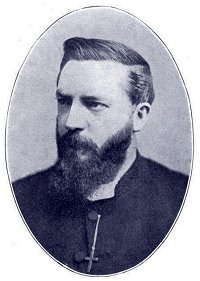I believe in the holy catholic church, the communion of the saints.
Hymn writers frequently relate varied inspirations for their texts. Great hymns of the church may be borne out of personal life events, societal or world events, or, as in the case of “The Church’s One Foundation,” theological controversy.
Samuel J. Stone (1839-1900) wrote this hymn as part of his response to a theological dispute that erupted when he was a young curate serving the Church of England in Windsor. John Colenso (1814-1988), the South African bishop of Natal, wrote a book in which he renounced some foundational tenets of the Christian faith. Stone responded with Lyra Fidelium: Twelve Hymns on the Twelve Articles of the Apostle’s Creed (1866). This series of hymns fleshed out the basic Christian beliefs espoused in the creed, enabling congregations to sing with an understanding of their beliefs.

Beverly Howard
Realizing the importance of people understanding the statement of faith they recited regularly, Stone offered this rationale in the Preface:
Most clergymen are aware how many of their parishioners, among the poor especially, say the Creed in their private prayers. And they cannot but feel how this excellent use, as also its utterance in public worship, is too often accompanied by a very meagre comprehension of the breadth and depth of meaning contained in each article of the Confession of Faith. Such a feeling first suggested to the author the probable usefulness of a simple and attractive explanation of the creed in the popular form of a series of hymns, such as might be sung or said in private devotion, at family prayer, or in public worship.
“The Church’s One Foundation,” based on the ninth article of the Apostle’s Creed, speaks to the church unified by origin, faith, sacraments and mission. Although the church experiences controversy or dissension, she may be confident of its future in Christ.
Stone’s hymn is no mere didactic summation of the creed; he imbues the text with scriptural imagery and teaching.
The first stanza boldly proclaims Christ as the foundation (Ephesians 2:20, Colossians 1:18) of his “new creation” (Ephesians 5:26-27), cleansed by “water and the word.”
Stanza two celebrates a church of global proportion and membership, yet unified in professing “one Lord, one faith, one birth” (Ephesians 4:4-6).

Samuel J. Stone
Stanzas three and four address the reality of church conflicts, a direct reference to the doctrinal divisions facing the Church of England in the 19th century. Amid schisms and heresies, there is hope that the saints are keeping watch and “soon the night of weeping shall be the morn of song” (Revelation 6:10). The glorious final stanza assures us of the communion we enjoy now with the Trinity and with saints past and present.
The church is no stranger to controversy, and Stone was not the first theologian to write hymns to combat perceived heresies. When the fourth-century church struggled with the doctrine of the trinity, theologians on both sides of the controversy wrote hymns to unite their followers and disseminate their divergent doctrinal stances.
Sadly, today’s church is no more immune from conflict than in earlier generations, with dissension periodically erupting locally and at the denominational level. Local congregations still experience conflicts over the color of the new carpet, the budget or worship styles. Painful, divisive denominational disputes still erupt over substantive doctrinal differences. Singing this text gives witness to past conflicts the church endured and faith in what the church will become in Christ.
Stone’s complete hymn included seven stanzas, of which only five are commonly published. The following stanza, which seldom appears in current hymnals, assures us of the great promise that through Christ the church will endure.
The Church shall never perish!
Her dear Lord to defend,
To guide, sustain, and cherish,
Is with her to the end:
Though there be those who hate her,
And false sons in her pale,
Against or foe or traitor
She ever shall prevail.
Shortly after the publication of the text, it was paired with the tune AURELIA by Samuel Wesley (1766-1837), with this pairing remaining in common use. This hymn enjoys congregational performance in large, festival settings such as in these recordings.
The hymn also translates well to intimate ensembles. And a new generation is creating original tunes for classical texts as in this recording by Indelible Grace.
Whenever we profess the familiar words of the Apostles’ Creed, we unite in our belief about the church. When we join in singing “The Church’s One Foundation,” we unite in affirming our belief in Christ’s church past, present and future.
Whether we sing this hymn in worship, at Reformation Day services, church anniversaries or in times of conflict, the text reminds us that as long as the church builds on Christ as its foundation, we will be part of healing and peace that is beyond our understanding.
Beverly A. Howard lives in Fort Worth, Texas. She is a retired university music professor, former editor of The Hymn: A Journal of Congregational Song, and member of hymnal committees that prepared Glory to God: The Presbyterian Hymnal and Celebrating Grace: Hymnal for Baptist Worship. She is one of the collaborating authors of Sing with Understanding, Third Edition: An Introduction to the Theology of Christian Congregational Song (2022) with Martin V. Clarke, C. Michael Hawn, and Geoffrey Moore.
Other articles in this series:
Hymn Stories: ‘Will You Come and Follow Me’
Hymn stories: ‘Christ is alive! Let Christians sing’
Hymn stories: Lord, Who Throughout These 40 Days


